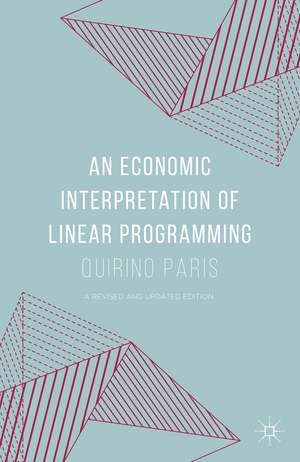An Economic Interpretation of Linear Programming
Autor Quirino Parisen Limba Engleză Hardback – 15 dec 2015
Preț: 654.30 lei
Preț vechi: 769.77 lei
-15% Nou
Puncte Express: 981
Preț estimativ în valută:
125.22€ • 130.24$ • 103.37£
125.22€ • 130.24$ • 103.37£
Carte tipărită la comandă
Livrare economică 12-26 aprilie
Preluare comenzi: 021 569.72.76
Specificații
ISBN-13: 9781137573919
ISBN-10: 1137573910
Pagini: 476
Ilustrații: XIX, 454 p.
Dimensiuni: 155 x 235 x 27 mm
Greutate: 0.8 kg
Ediția:Revizuită
Editura: Palgrave Macmillan US
Colecția Palgrave Macmillan
Locul publicării:New York, United States
ISBN-10: 1137573910
Pagini: 476
Ilustrații: XIX, 454 p.
Dimensiuni: 155 x 235 x 27 mm
Greutate: 0.8 kg
Ediția:Revizuită
Editura: Palgrave Macmillan US
Colecția Palgrave Macmillan
Locul publicării:New York, United States
Cuprins
1. Introduction to Linear Programming
2. Primal and Dual LP Problems
3. Setting Up LP Problems
4. The Transportation and Transshipment Problems
5. Spaces, Cones, Bases and Extreme Points
6. Solving Systems of Equations
7. Primal Simplex Algorithm: The Price-Taking Firm
8. The Dual Simplex Algorithm
9. Linear Programming and the Lagrangean Function
10. The Artificial Variable Algorithm
11. The Artificial Constraint Algorithm
12. The Diet Problem Revisited
13. Parametric Programming: Input Demand Functions
14. Parametric Programming: Output Supply Functions
15. Dealing with Multiple Optimal Solutions
16. Solid Waste Management
17. The Choice of Techniques in a Farm Production Model
18. Cattle Ranch Management
19. The Measurement of Technical and Economic Efficiency
20. Decentralized Economic Planning
21. Theorems of Linear Programming
2. Primal and Dual LP Problems
3. Setting Up LP Problems
4. The Transportation and Transshipment Problems
5. Spaces, Cones, Bases and Extreme Points
6. Solving Systems of Equations
7. Primal Simplex Algorithm: The Price-Taking Firm
8. The Dual Simplex Algorithm
9. Linear Programming and the Lagrangean Function
10. The Artificial Variable Algorithm
11. The Artificial Constraint Algorithm
12. The Diet Problem Revisited
13. Parametric Programming: Input Demand Functions
14. Parametric Programming: Output Supply Functions
15. Dealing with Multiple Optimal Solutions
16. Solid Waste Management
17. The Choice of Techniques in a Farm Production Model
18. Cattle Ranch Management
19. The Measurement of Technical and Economic Efficiency
20. Decentralized Economic Planning
21. Theorems of Linear Programming
Recenzii
“This book is suitable for anyone who wants to study LP and its applications, especially in economics. The content of the book is well structured in order to help readers understand the concepts of LP. … this is must-read book for anyone who wants to thoroughly study LP, its economic interpretation and the theorems behind the concepts.” (Dharma Lesmono, Mathematical Reviews, September, 2018)
“This book, divided in 21 chapters, studies in great extent the field of linear programming with an emphasis to its applications and the economic interpretation of the problem statement and results. … This book is very easy to follow and presents an excellent overview of the field of linear programming bothfor first time readers and for experienced researchers in the field.” (Efstratios Rappos, zbMATH 1364.90001, 2017)
“This book, divided in 21 chapters, studies in great extent the field of linear programming with an emphasis to its applications and the economic interpretation of the problem statement and results. … This book is very easy to follow and presents an excellent overview of the field of linear programming bothfor first time readers and for experienced researchers in the field.” (Efstratios Rappos, zbMATH 1364.90001, 2017)
Notă biografică
Quirino Paris spent his entire academic career at the University of California, USA, earning a PhD from Berkeley in 1966 and serving as Professor of Agricultural Economics at UC Davis from 1969. In 2011 he published a companion book titled Economic Foundations of Symmetric Programming. He is a Fellow of the American Applied Economic Association and of the European Association of Agricultural Economists.
Textul de pe ultima copertă
This text covers the basic theory and computation for mathematical modeling in linear programming. It provides a strong background on how to set up mathematical proofs and high-level computation methods, and includes substantial background material and direction. Paris presents an intuitive and novel discussion of what it means to solve a system of equations that is a crucial stepping stone for solving any linear program. The discussion of the simplex method for solving linear programs gives an economic interpretation to every step of the simplex algorithm. The text combines in a unique and novel way the microeconomics of production with the structure of linear programming to give students and scholars of economics a clear notion of what it means, formulating a model of economic equilibrium and the computation of opportunity cost in the presence of many outputs and inputs.













